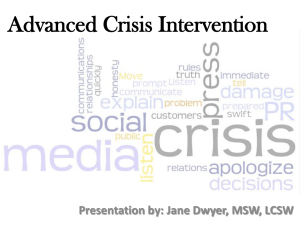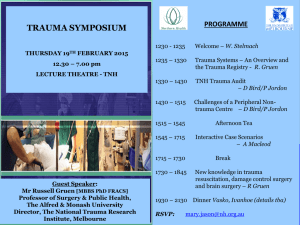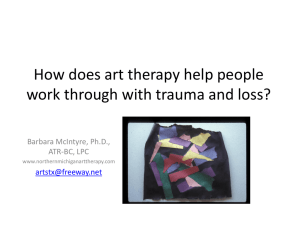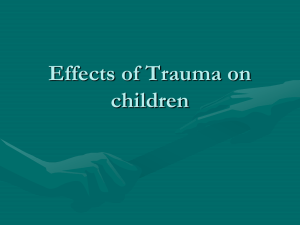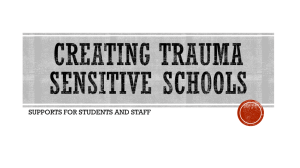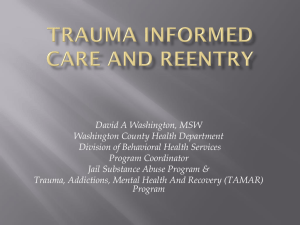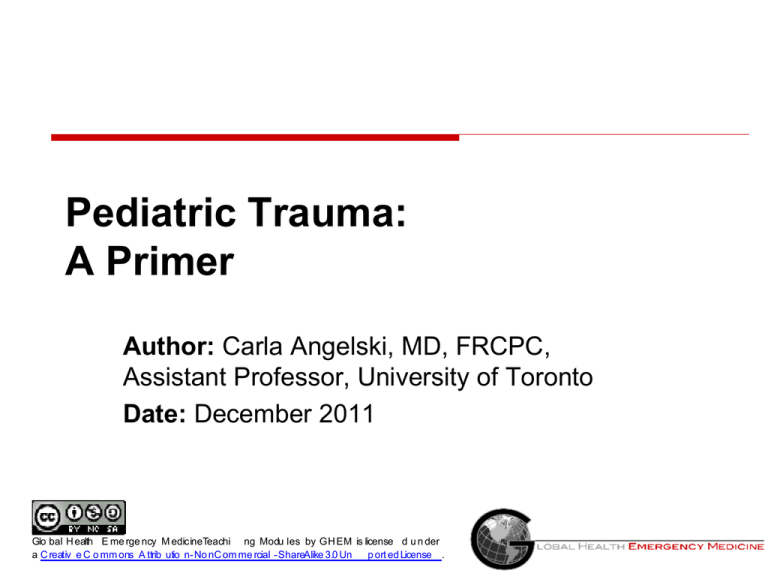
Pediatric Trauma:
A Primer
Author: Carla Angelski, MD, FRCPC,
Assistant Professor, University of Toronto
Date: December 2011
Glo bal H ealth E me rge ncy M edicineTeachi ng Modu les by GH EM is license d u n der
a C reativ e C o mm ons A ttrib utio n-No nC om me rcial -ShareAlike 3.0 Un
p ort ed License .
Learning Objectives
The student should understand the utility and benefit
of the primary and secondary surveys
The student will describe adjuncts of the primary and
secondary survey and when to use them
The student should gain exposure to general
categories of pediatric trauma
The student will understand that pediatric trauma is
above all preventable
Epidemiology1,2
25% of traumatic injuries occur in
children
Trauma is the leading cause of death
after infancy (age 1-14y)
Epidemiology2,3,4
Most common causes of injury-related
deaths:
Traumatic brain injury
Motor vehicle crashes
Submersion injury
Homicide
Suicide
Fires
Epidemiology2,3,5,36
Data from 2002 shows > 700 000 injury-related
deaths world-wide occur in the <15 year old age
group
Bimodal distribution in injury death rates:
Children and Teens
Teens are at increased risk due to:
Increased exposure to hazards
Risk-taking behaviors
Infants:
Are at higher risk of inflicted trauma
Epidemiology3,5,6,7
Males at higher risk of death from ALL
injury types
Minority and low-income children at higher
fatal and non-fatal rates of traumatic injury
Epidemiology3
Pediatric specific trauma centers first
developed in 1970’s in North America
Children at these centers do better than
predicted by trauma triage scores
Trauma triage scores were developed to
predict which patients require trauma center
care
Can assist physicians in determining level
of triage
Trauma Triage Scores3, 8-11
Examples include:
Revised Trauma Score (RTS)
Pediatric Trauma Score (PTS)
Injury Severity Score (ISS)
Prevention3,12,13
Trauma has patterns and risk factors
Identifying high-risk populations can help target
interventions
Examples:
Seatbelts
Car Seats
Helmets (for bicycle riding)
Fire Safety courses
Swimming lessons
Emergency Preparedness14,15,16
Broselow© specific crash cart
Broselow© tape
Equipment and medication stocked as per
published guidelines
Consider Canadian guidelines:
http://www.cps.ca/english/statements/cp/cp09-03.htm
Or American Guidelines
http://www.acep.org/content.aspx?id=29134
Or Australian standards for resuscitation:
http://www.resus.org.au/clinical_standards_for_resuscitation_m
arch08.pdf
http://www.cps.ca/english/statements/cp/cp09-03.htm
http://www.cps.ca/english/statements/cp/cp09-03.htm
http://www.cps.ca/english/statements/cp/cp09-03.htm
http://www.cps.ca/english/statements/cp/cp09-03.htm
PRIMARY AND SECONDARY
SURVEYS
Primary & Secondary Survey3,17
Primary survey:
Quick, initial patient assessment to identify lifethreatening injuries
Occurs with active resuscitation
Secondary survey:
More detailed assessment of injuries
Primary Survey3
A,B,C,D,E
Every trauma patient should arrive
boarded and C-spine immobilized
Collar for school-age/adolescents
Rolls and tape for infants/toddlers
Immediate vitals signs
A,B,C,D,Es
A = Airway & C-Spine Precausions
B = Breathing
C = Circulation
D = Disability
E = Exposure
A: Airway & C-Spine Protection3
Check for airway patency and clear
secretions such as:
Blood, foreign bodies, loose teeth
Assess need for intubation
If there are facial burns that extend to the
mouth or signs of inhalation injury –
INTUBATE EARLY!
Ensure adequate C-spine protection
C-Spine Injuries3
Overall rare
Associated with 1.2% of pediatric trauma
After 8y, spine anatomically similar to adult
Children <14y = injury C1-C4 more common
Fulcrum immature spine C2-C3
Children >14y = injury C5-C7 more common
Fulcrum mature spine C5-C6
B: Breathing3
Check for adequacy of breathing
Effort, breath sounds, oxygenation
Apply oxygen by facemask or blowby
Consider need for intubation
If already intubated confirm ETT position with:
Chest x-ray if available
End tidal CO2 or pedi-cap if available
Oxygen saturation if available
Auscultate the lungs for equal air entry
Take a look with a laryngoscope
C: Circulation3
Most common cause of shock in pediatrics =
hypovolemia
TBV of child = 80ml/kg
2 large bore IV’s started
Xmatch or Type and screen ordered
20 ml/kg IV crystalloid bolus (x 3 then
PRBC’s)
Look for obvious and non-obvious sources of
bleeding
D: Disability3
Pupils reactive? Equal?
GCS (modified) or Verbal Score
Spontaneously moving?
Obvious deformities?
Pediatric Verbal Score
Verbal Response
V-Score
Appropriate words/coos
Smiles, fixes/follows
5
Cries but consoles
4
Persistently irritable
3
Restless, agitated
2
None
1
From American College of Surgeons’ Committee on Trauma. Advanced Trauma Life Support for Doctors (ATLS) Student Manual
. 7th ed. Chicago: American College of Surgeons; 2004.
Glasgow Coma Scale (GCS)3
Eye Opening
Spontaneous 4
To voice 3
To pain 2
None 1
Verbal Response (Peds)
Appropriate 5
Cries, consoles 4
Persistently irritable 3
Restless, agitated 2
None 1
Motor Response
Obeys Commands 6
Localizes pain 5
Withdraws to pain 4
Flexion with pain 3
Extension to pain 2
None 1
E: Exposure
Assess all surface areas
Log-roll with using spinal precautions
Examine the spine: note step deformities or
pain
Assess rectal tone and sensation
Check for vaginal/urethral bleeding
Prevent hypothermia
Keep trauma room warm, use blankets and
overhead warmer for infants
History3
Ask about the Mechanism of injury:
Speed, distance thrown, fall from
height, landing surface, accident?
What protective devices used?
Seatbelts, carseats, helmets
What were the initial findings and vitals
on scene (if available)
Primary Survey Goals13
IDENTIFY
INTERVENE
Airway
Inadequate airway
Secure and protect
Breathing
Apnea
Positive pressure ventilation
Hypoxia
Supplemental oxygen
Tension pneumothorax
Needle decompression, chest tube
Massive hemothorax
Chest tube
Open pneumothorax
Occlusive dressing, chest tube
Primary Survey Goals13
IDENTIFY
INTERVENE
Circulation
Hypovolemic shock
Fluid bolus, blood products
Pericardial tamponade
Fluid bolus, pericardiocentesis,
thoracotomy
Cardiac Arrest
Chest compressions, thoracotomy
if penetrating trauma
Disability
Spinal cord injury
Immobilization
Cerebral herniation
Hyperventilation, mannitol
Exposure
Hypothermia
Warmed fluid, external warming
Exsanguinating hemorrhage
Direct pressure
Adjuncts to Primary Survey3
Access: Intravenous or Intraosseous needles
Monitor: Cardiorespiratory/Pulse oximetry; size
appropriate blood pressure cuff
Imaging (x-rays)
Trauma bloodwork
CBC, electrolytes, blood gas, creatinine, BUN,
PT/PTT, Xmatch, liver function studies, lipase or
amylase
BHCG if female of child-bearing age
Consider Toxicology screen and cardiac enzymes
if appropriate
Imaging Prior to Secondary Survey
Xrays:
CXR (AP only)
Pelvis (AP only)
C-spine: lateral, AP and odontoid
if cooperative
Secondary Survey
Head to toe examination
Tetanus status
IV antibiotics if necessary
AMPLE history: allergies,
medications, past medical history,
last meal, events surrounding injury
Vascular Access - The IO Needle3
If unable to secure access in 90 seconds =
IO
Provides immediate vascular access when
needed
Safe to administer fluids, drugs, blood
products
Can be left for up to 72h
Use until more secure vascular access
The IO Needle:
Relative Contraindications3
Underlying fracture
Overlying infection
Previous attempt at same site
Osteogenesis Imperfecta
Procedure
14 to 20 gauge IO needle with stylus (or EZ
IO gun if available)
Prepare area in sterile fashion and use
local anesthetic
Landmarks:
Proximal medial aspect of tibial plateau, 1-2cm
distal to tuberosity (aiming away from growth plate)
Distal femur, 1-2cm proximal to superior border of
patella
Procedure3
Insert needle at 900 angle to bony surface
Avoid putting hand behind limb where IO inserted
Slowly twist after puncturing the skin until
‘release’ is felt
You may or may not aspirate marrow, this is not
always possible or necessary
Connect to IV tubing
Secure to skin with tape and gauze
IO Insertion
http://emedicine.medscape.com/article/940993-overview
Head Trauma
Head Trauma3,18,19,20
Head trauma is the leading cause of death &
disability in childhood
Mortality rate 20-30%
0-14y age range TBI = 400 000 visits/year to ED
1-2% of all comers to ED
Only 3-5% of those with intracranial injury
<1% of above require neurosurgery
Head Trauma21
Epidemiological/Environmental factors:
Infancy: NAT, falls
Childhood: MVA, pedestrian, bicycle
Adolescence: MVA, pedestrian, bikes/boards,
violence
Sex:
M = F ~ 5 yo
M > F > 5 yo (2-5:1)
Head Trauma: Pathophysiology
Cerebral blood flow depends on both autoregulation
and the Central Perfusion Pressure
CPP = MAP – ICP
If autoregulation is lost, CBF is solely dependant on
CPP
If the ICP increases secondary to an intracranial injury
(for example a bleed), a time will come when the MAP
cannot overcome the resistance provided by the ICP,
and cerebral perfusion will slow down
Age Related Differences21
Anatomical age related differences:
Children have larger heads compared to body ratio
Higher water content (88% vs 77%)
softer, prone to acceleration-deceleration injury
Water content inversely proportional to
myelinization
More susceptible to shear injuries
Open sutures – tolerate higher ICP better
Common Signs & Symptoms of
Increased ICP in Children22
Full fontanel
Splitting sutures
Altered state of cosciousness
Paradoxical irritability
Persistent emesis
Cranial nerve paralysis
Papilledema
Cushing’s Triad:
Hypertension, bradycardia and hyperventilation
Decorticate or decerebrate posturing
Etiology3
Diffuse axonal injury more common in children than
adults
Require less neurosurgical intervention
Epidural hematomas are a neurosurgical emergency –
most often follow trauma to temporal region
Consider if period of LUCIDITY followed by
deterioration
Subdural hematomas – be suspicious for nonaccidental Trauma (NAT) if no history of trauma
Acute Medical Management of
Raised ICP3,13
Position head of bed at 300
Mannitol IV 20% = 1g/kg per dose
Must chase with bolus of NS
Prevent hypoxia and hypotension
CPP = MAP – ICP
Focus on maintaining MAP’s with IV fluids
Control external hemorrhage
Maintain C-spine precautions
Early intubation using RSI to prevent complications
Rapid Sequence Intubation of the
Head Injured Child 3,23,24
Consider pre-treatment with Atropine if <1yo
Consider pre-treatment with Lidocaine at least 5-10
minutes prior to intubation
Thiopental 2-4mg/kg, Propofol 1mg/kg, fentanyl 13mcg/kg or etomidate 0.3mg/kg all appropriate
choices
Know adverse events associated with each before
you use them!
MUST maintain CPP therefore ensure adequate
PRELOAD with IV fluids
Succinylcholine or Rocuronium for paralysis
Head Injury
Definitive management dependant on
lesion and examination
Early involvement of neurosurgery
recommended
Admission for observation and closely
monitoring for deterioration a must
Consider need for IV Mannitol early for
raised intracranial pressure
Chest Trauma
Chest/Thoracic Trauma3,25
Accounts for 4.5 – 8% pediatric trauma
2nd most common cause of mortality in
pediatric trauma
Most common causes:
Motor vehicle accidents (MVA’s)
Pedestrians
Unrestrained passengers
Bicycle riders
Falls
Chest/Thoracic Trauma3
Pediatric thoracic trauma higher risk:
More compliant chest wall
Increased mediastinal mobility
Tension pneumothorax develops quicker
Children more prone to hypoxia
Less ability to compensate for
hypovolemia
Chest/Thoracic Trauma3,26
Blunt versus penetrating
Blunt:
High energy trauma affects internal organs
Deceleration mechanisms affect mediastinal
structures
Penetrating:
Disrupts underlying structures
Do not remove penetrating objects! Must remove
in a controlled setting (Operating Room)
Chest/Thoracic Trauma
Consider:
Hemothorax
Pneumothorax (+/- Tension Pneumothorax)
Flail chest
Diaphragmatic ruptures
Bronchial/Tracheal tears
Esophageal ruptures
Pulmonary contusions
Commotio Cordis
Cardiac tamponade
Tension Pneumothorax
Hypotension, distended jugular veins, shifted
heart sounds, hyper-resonance, trachea not
midline
Treatment:
Emergent needle decompression = Large bore IV
inserted over rib in 2nd ICS after sterile drape/prep
if possible
Consider 3-way stopcock to continue drawing off
air
Chest tube needed for definitive management
Chest Tube Insertion
For an approach to chest tube insertion:
Mikrogianakis A et al. The Hospital for Sick Children Manual of Pediatric Trauma. 1st ed.
Philadelphia: Lippincott Williams & Wilkins; 2008: 258-262.
http://flylib.com/books/en/2.569.1.21/1/
Abdominal Trauma
Abdominal Trauma3,22
3rd leading cause of traumatic death
Often unrecognized in children
Consider abdominal injury in the following:
Sign
Possible Injuries
Seatbelt Injury
Small bowel injury
Chance fracture
Handlebar injury
Duodenal hematoma
Pancreatic injury
Sport related injury
Spleen, kidney, bowel
Abdominal Trauma3,27,28
What are the odds of having intraabdominal injury?
Based on the Abdominal Exam:
Tenderness on exam = OR 40.7 of IAI
Ecchymosis = OR 15.8
Abrasions = OR 16.8
Based on other findings:
Low blood pressure = OR 4.1
ALT >125, or AST >200 = OR 17.4
UA showing >5RBC/hpf = OR 4.8
Abdominal Trauma3
Repeat abdominal exams cornerstone of
diagnosis
Abdominal Trauma3
If unstable vitals, indication for OR
FAST to look for free fluid in the abdomen,
which may indicate the presence of intraabdominal bleeding.
IV contrast enhanced CT gold standard for
diagnosis of stable patient
Definitive management dependant upon
specific organ injured
Burns/Thermal Injury
Burns/Thermal Injury3,13,29
70% pediatric burns secondary to hot liquid
Up to 20% burns in younger children
secondary to abuse or neglect
Consider inhalational injury and need for
EARLY intubation if not secondary to liquid
Hoarseness
Black sputum
Facial burn
Accident in closed area
Burns 13,30
Burn Assessment
Depth
1st degree: superficial (epidermis)
2nd degree: superficial or deep partial thickness
(dermis)
3rd degree: full thickness (beyond dermis)
http://www.unboundedmedicine.com/pics/burn.jpg
Burns
4th degree: involves underlying
subcutaneous tissue, tendon, bone
Burn/Thermal Injury 13,22
Burn Assessment
Time to healing
Appearance
Surface
Sensation
1st degree
Pink or red
Dry
Painful
Days
Superficial
2nd degree
Pink, clear
blisters
Moist
Painful
14–21 days
Deep 2nd degree
Pink,
hemorrhagic
blisters, red
Moist
Painful
Weeks, or may progress
to 3rd degree and
require graft
3rd degree
White, brown
Dry, leathery
Insensate
Requires excision
4th degree
Brown, charred
Dry
Insensate
Requires excision
Burn/Thermal Injury 3,13
Estimating Burn Size
Palm of patient’s
hand = ~ 1% BSA
Burn/Thermal Injury: Management3
ABCDE’s
Consider early intubation if airway involvement
Tetanus prophylaxis and ANALGESIA
Fluid resuscitation mainstay of treatment
Parkland Resuscitation Formula: using Ringer’s
Lactate
Give 4ml/kg/%TBSA
First half of resuscitation fluids (AS WELL AS
MAINTENANCE FLUIDS) over first 8 hours
Second half over following 16 hours
u/o goal: 1-2 ml/kg/hour
Burn/Thermal Injury3
Pediatric Considerations:
Electrolytes must be monitored closely
Glucose should be added to maintenance fluids
once resuscitation phase complete
Albumin use during resuscitation phase not
indicated, likely harmful
Nutritional (enteral) support necessary and should
begin within first 6 hours
At risk for immunosuppression – However, no role
for prophylactic antibiotics
Burn/Thermal Injury3
Consider referral to a burn centre if:
Inhalational injury
Burn size >10% TBSA in child <10yo
Burn size >20% in any patient
Full-thickness burns >5% TBSA
Burn involving hands/feet/face/perineum
Mutiple comorbidities
NAT
Chemical/Electrical injury
Submersion Injuries
Submersion Injuries3,31,32
500 000 deaths due to drowning per year
worldwide
>50% drowning victims <5yo
Fatality is highest in children <5yo
M>F
Most common cause of cardiac arrest in
children
Submersion Injury3,33
Most common sites of drowning:
<1yo : Bathtubs (55%)
1 – 4yo : Pools (56%)
>4yo : Freshwater (63%)
Definition of drowning versus Near
Drowning:
Drowning = death within 24h of suffocation
from submersion in liquid
Near Drowning/Submersion injury = survival
>24h past event
Submersion Injury3
Pathophysiology of drowning:
Accidental submersion
Loss of normal breathing pattern
Possible laryngospasm
Pulmonary aspiration/breath-holding/apnea
Hypoxemia:
Low O2, hypercarbia, acidosis
End-organ damage – circulatory arrest
Submersion Injury3,34
ABCDE’s
Consider early intubation
Always consider C-spine immobilization
0.5% submersion victims have c-spine injury
Remove wet clothing
Treat hypothermia
Poor Prognosis in Submersion
Injury3,35
Prolonged submersion >25 minutes
Delay in CPR initiation
Resuscitation >25 minutes
pH <7.1
Pulseless, cardiac arrest on arrival to emergency
department
Elevated blood glucose on arrival
Dilated and fixed pupils on arrival
Abnormal initial CT of brain
Initial GCS of <5
Injury Prevention
Injury Prevention3
90% injuries can be prevented
Supervision and understanding child
development critical in keeping them safe
Injury Prevention3
Bike Helmets:
If properly fitted can decrease risk of injury by
85%!
Window Stops/Guards:
Screens not effective barriers
Smoke alarms:
3x greater risk of death in homes without them!
Medication:
Must be LOCKED and inaccessible
Injury Prevention3
Carbon Monoxide Detectors:
Install near sleeping areas
Hot Water Temperature:
Reduce tap temperature to <49oC
Water Safety:
SUPERVISION at ALL times
Life jacket use
4 sided fencing for pools (1.2m high, selflatching gate)
Injury Prevention3
Street Safety
Children <9yo do not judge traffic safely
Cannot determine how vehicles are moving
Have underdeveloped peripheral vision
Should NOT cross the road WITHOUT an ADULT
Choking/Strangulation
<4yo should not eat raw carrots, candies, popcorn,
hotdogs, or have access to small toys
Children should sleep in own crib, on their back,
with well-fitted bedding to decrease risk of SIDS
Conclusion
Pediatric trauma and injury are preventable
conditions
Principles of management should always
include a well orchestrated primary and
secondary survey
Never hesitate to admit for observation, ask
for help or consult specialty services -the
earlier the better.
References
1.
Resources for optimal care of the injured patient. Chicago: American College of Surgeons, Committee on Trauma;
1998:39-42.
2. Down DM, Keenan HT, Bratton SL. Epidemiology and prevention of childhood injuries. Crit Care Med 2002;30 No.
11:S385-392.
3. Mikrogianakis A, Valani R, Cheng A. Introduction. In: The Hospital for Sick Children Manual of Pediatric Trauma. 1st ed.
Philadelphia: Lippincott Williams & Wilkins; 2008: 1-6.
4. Tintinalli, J. E., & Stapczynski, J. S. (2011). Tintinalli's emergency medicine: A comprehensive study guide. New York:
McGraw-Hill.
5. Baker SP, O’Neill B, Ginsberg MJ, et al. (Eds.) Unintentional injury. In: The injury Fact Book. 2nd ed. New York: Oxford
University Press; 1992:39-77.
6. Pomerantz WJ, Dowd MD, Buncher CR. Relationship between socioeconomic factors and severe childhood injuries. J
Urban Health 2001; 78:141-151.
7. Durkin MS, Davidson LL, Kuhn, et al. Low-income neighborhoods and the risk of severe pediatric injury: A small area
analysis of northern Manhattan. Am J Public Heatlh 1994; 84:587-92.
8. Champion HR, Sacco WJ, Copes NW, et al. A revision of the trauma score. J Trauma 1989;29:623-629.
9. Tepas JJIII, Mollitt DL, Talbert JL, et al. The pediatric trauma score as a predictor of injury severity in the injured child. J
Pediatr Surg 1987;22:14-18.
10. Tepas JJ III, Ramenofsky ML, Mollitt DL, et al. The pediatric trauma score as a predictor of injury severity: an objective
assessment. J Trauma 1988;28:425-429.
11. Marcin JP, Pollack MM. Triage scoring systems, severity of illness measures, and mortality prediction models in pediatric
trauma. Crit Care Med 2002;30:S457-S467.
12. Scholer SJ, Hickson GB, Rjay WA. Sociodemographic factors identiy U.S. infants at high risk of injury mortality.
Pediatrics 1999;102:1183-1188.
References
13. Erbes, J (2011). Pediatric Trauma: Trends and Trauma Conference [Powerpoint slides]. Retrieved from
http://www.wheatoniowa.org/webres/File/Trends%20in%20Trauma%20documents/Pediatric%20Trauma%20Presentation
%20TNT%202011.ppt.
14. Agarwal S, Swanson S, Allison M et al. Comparing the utility of a standard pediatric resuscitation cart with a pediatrc
resuscitation cart based on the broselow tape: a randomized controlled, crossover trial involving simulated resuscitation
scenarios. Pediatrics 2005;116(3):e326-e333.
15. http://www.cps.ca/english/statements/cp/cp09-03.htm
16. http://www.resus.org.au/clinical_standards_for_resuscitation_march08.pdf
17. . American College of Surgeons Committee on Trauma. Advanced trauma life support for doctors. 7th ed. Chicago:
American College of Surgeons;2005.
18. Keenan HT , Bratton SL. Epidemiology and outcomes of pediatric traumatic brain injury. Dev Neurosci 2006;28:256-263.
19. Sharples PM. Head injury in chlidren. In: Little RA, Platt W, eds. Injury in the young. Cambridge: Cambridge University
Press; 1998:151-175.
20. Theissen ML, Woolridge DP. Pediatric minor closed head injury. Pediatr Clin North Am 2006;53:1–26.
21. Avarello JT, Cantor RM. Pediatric major trauma: an approach to evaluation and management. Emerg Med Clin NA
2007;25:803-836.
22. . Rosen, P., Marx, J. A., Hockberger, R. S., & Walls, R. M. (2009). Rosen's emergency medicine: Concepts and clinical
practice. Edinburgh: Mosby.
23. Ped Emerg Care 2005;21:637-38
24. Emerg. Med. J. 2001;18;453-457
25. Eichelberger MR. Pediatric trauma: prevention, acute care, rehabilitation. St Louis: Mosby Year Book;1993.
References
26. Sartorelli KH, Vane DW. The diagnosis and management of children with blunt injury of the chest. Semin Pediatr Surg
2004;13: 98-105.
27. Cotton BA, Beckert BW, Monica K, et al. The utility of clinical and laboratory data for predicting intra-abdominal injury
among children. J Trauma 2004;56:1068-1075.
28. Holmes JF, Sokolove PE, Land C, et al. Identification of intra-abdominal injuries in children hospitalized following blunt
torso trauma. Acad Emerg Med 1999;6:799-806.
29. Rossignol AM, Boyle CM, Locke JA et al. Hospitalized burn injuries in Massachusetts: an assessment of incidence and
product development. Am J Public Health 1986;76;1341-1343.
30. http://www.unboundedmedicine.com/pics/burn.jpg
31. Peden MM, McGee K. The epidemiology of drowning worldwide. Inj Control Saf Promot 2003;10:195-199.
32. Quan L, Cummings P. Characteristics of drowning by different age groups. Inj Prev 2003;9:163-168.
33. Brenner RA, Trumble AC, Smith GS, et al. Where children drown, United States. Pediatrics 2001;108:85-89.
34. Watson RS, Cummings P, Quan L, et al. Cervical spinal injuries among submersion victims. J Trauma 2001;51:658-662.
35. Zuckerman GB, Conway EE. Drowning and near drowning: a pediatric epidemic. Pediatr Ann 2000;29:360-382.
36. http://www.who.int/violence_injury_prevention/child/injury/statistics/en/index.html
Quiz Question 1
The purpose of the primary survey is to:
Identify non-life-threatening issues so you
know who to refer to.
Identify immediately life-threatening issues and
treat them.
Identify what adjuncts such as CT, Xray series
or bloodwork is needed.
Undertake a complete head to toe exam and
identify every issue the patient presents with.
Quiz Question 2
Every trauma patient should arrive boarded
and in C-spine precautions:
True
False
Quiz Question 3
Relative contraindications of the use of the
intraosseous needle include all except:
1.
2.
3.
4.
5.
Underlying fracture
Overlying infection
Previous attempt at same site
Osteogenesis Imperfecta
Unstable vital signs
Quiz Question 4
CPP is best described by which
relationship:
1.
2.
3.
4.
CPP = MAP – ICP
CPP = MAP + ICP
MAP = CPP – ICP
ICP = MAP x CPP
Quiz Question 5
What percentage of injuries in children are
preventable?
1.
2.
3.
4.
None of them, children are unpredictable.
Around 10%
Between 15-130%
>90%




